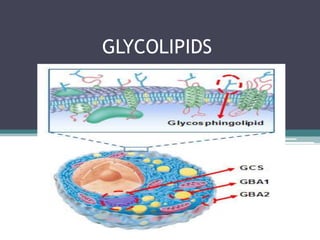
Attachments
- 2. They are lipids that contain carbohydrate residues with sphingosine as the alcohol and a very long-chain fatty acid (24 carbon series). They are present in cerebral tissue, therefore are called cerebrosides Definition:
- 3. Carbohydrate and lipid components. Derivatives of ceramide. Essential components of all membranes, greatest amount in nerve tissue. Interact with the extracellular environment. No phospholipid but oligo or mono-saccharide attached to ceramide by O-glycosidic bond.
- 4. Glycosphingolipids are antigenic, for example; blood group antigen. various embryonic antigens. tumor antigen. The carbohydrate portion of a glycolipid is the antigenic determinant. Glycolipids also serve as cell surface receptor for cholera and tetanus toxins and for certain viruses and Microbes.
- 6. Classification of Glycosphingolipids Classification of glycolipids depend on the number and type of carbohydrate moieties present. Neutral glycosphingolipids :- cerebrosides: ceramidemonosacharides that contain either a molecule of galactose or glucose, found predominately in the brain and peripheral nervous tissue with high concentration in the myeline sheath. Galactocerebroside : Cer-Gal Glucocerebroside : Cer-Glc
- 8. Globosides: ceramide oligosaccharide attached by additional monosacharides (galactoseN-acetylgalactosamineNac ) to glucocerebroside Lactosylceramide : Cer-Glc-Gal Frossman antigen: Cer-Glc-Gal-Gal-GalNac-GalNac
- 10. Acidic glycosphingolipids:- Negatively charged at physiological pH due to N- acetylneuraminicacid (NANA) or sulfate group. 1. Ganglioside:ceramideoligosacharides with one or more molecule of NANA, found primarily in the ganglion cells of the CNS, patricularly at the nerve endings. The gangliosides (G) are divided according to the number of NANA molecule present in its structure into, Gm ,Gd, Gt, Gq.
- 11. They are more complex glycolipids that occur in the gray matter of the brain, ganglion cells, and RBCs. They transfer biogenic amines across the cell membrane and act as a cell membrane receptor. Gangliosides contain; sialic acid (N-acetylneuraminicacid), ceramide (sphingosine + fatty acid of 18-24 carbon atom length), Three molecules of hexoses (1 glucose + 2 galactose) and hexosamine. The most simple type of it the monosialoganglioside,. It works as a receptor for cholera toxin in the human intestine.
- 14. Sulfatides: cerebrosides that contain sulfated galactosylresidues , found predominantly in nerve tissue and kidney. sulfate group is usually attached to the OH group of C3 or C6 of galactose.
- 17. Synthesis of Neutral Glycosphingolipids Sequential addition of glycosyl monomers transferred from UDP-sugar donor to the acceptor molecule. Site – golgi apparatus Subtrates – Ceramide, sugar activated by UDP Galactocerobrosides – Ceramide + UDP- galactose Glucocerebrosides – Ceramide + UDP – glucose Enzymes – Glycosyltransferases
- 19. Synthesis of Acidic Glycosphingolipids Gangliosides--- ceramide + two or more UDP- sugars react together to form Globoside. NANA combines with globoside to form Ganglioside. Sulfatides----- 3´-hydroxyl group of galactocerebroside gets a sulphate group from a sulphate carrier, 3´-phosphoadenosine-5´- phosphosulfate (PAPS) with the help of sulfotransferaseand forms a sulfatide. Galactocerebroside 3-sulfate is the major sulfatide in the brain.
- 21. phosphatidylcholine UDP-galactose UDP-glucose UDP – diacylglycerol UDP UDP sugars SphingomyelinGalactocerebrosideGlucocerebrosidegloboside CMP-NANA PAPS CMP Sulfatide Ganglioside Ceramide
- 22. Degradation of glycosphingolipids Glycosphingolipids are internalized by endocytosis. Done by lysosomal enzymes. Lysosomal enzymes hydrolytically and irreversibly cleave specific bonds in the glycolipids. The degradation is a sequential process following the rule “ last on, first off “ in which the last group added during synthesis is the first group removed in degradation.